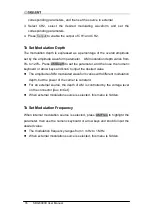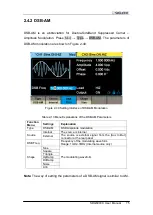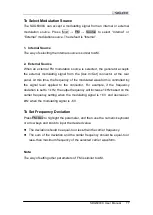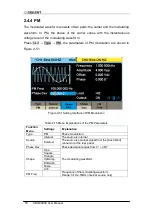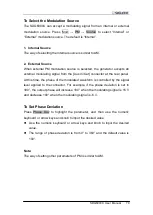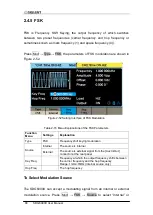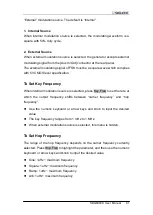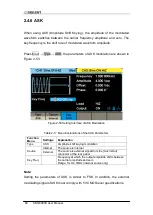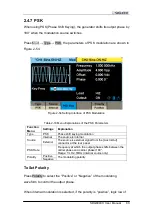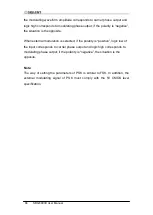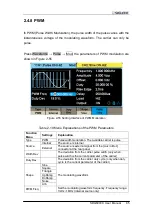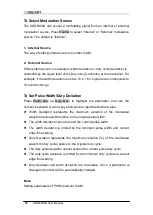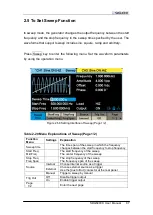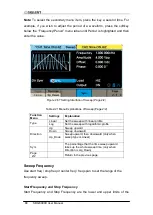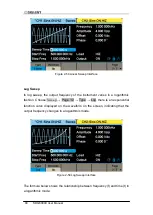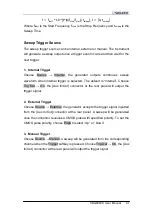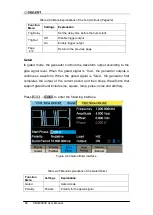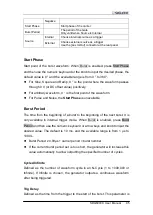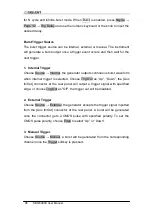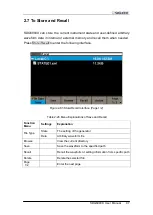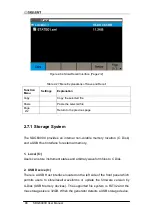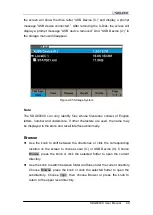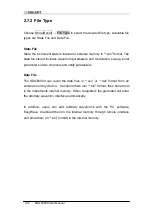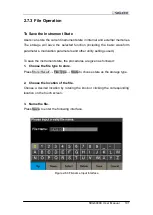
86 SDG6000X User Manual
To Select Modulation Source
The SDG6000X can accept a modulating signal from an internal or external
modulation source. Press Source
to select “Internal” or “External” modulation
source. The default is “Internal”.
1. Internal Source
The way of setting internal source is similar to AM.
2. External Source
When external source is selected, width deviation (or duty cycle deviation) is
controlled by the signal level of the [
Aux In/Out
] connector at the rear panel. For
example, if the width deviation is set as 10 s, +6 V signal level corresponds to
10 s width change.
To Set Pulse Width/Duty Deviation
Press Width Dev (or Duty Dev) to highlight the parameter, and use the
numeric keyboard or arrow keys and knob to input the desired value.
Width Deviation represents the maximum variation of the modulated
waveform pulse width relative to the original pulse width.
The width deviation cannot exceed the current pulse width.
The width deviation is limited by the minimum pulse width and current
edge time setting.
Duty Deviation represents the maximum variation (%) of the modulated
waveform duty cycle relative to the original duty cycle.
The duty cycle deviation cannot exceed the current pulse duty cycle.
The duty cycle deviation is limited by the minimum duty cycle and current
edge time setting.
Duty deviation and width deviation are correlative. Once a parameter is
changed, the other will be automatically changed.
Note:
Setting parameters of PWM is similar to AM.
Summary of Contents for SDG6000X Series
Page 2: ......
Page 45: ...SDG6000X User Manual 35 Figure 2 16 Setting the Bandwidth...
Page 142: ...132 SDG6000X User Manual Figure 2 95 Phase Deviation Interface...
Page 160: ...150 SDG6000X User Manual Figure 3 1 Generate a Sine Waveform...
Page 162: ...152 SDG6000X User Manual Figure 3 2 Generate a Square Waveform...
Page 175: ...SDG6000X User Manual 165 Figure 3 9 Generate an AM Modulation Waveform...
Page 177: ...SDG6000X User Manual 167 Figure 3 10 Generate a FM Modulation Waveform...
Page 179: ...SDG6000X User Manual 169 Figure 3 11 Generate a PM Modulation Waveform...
Page 181: ...SDG6000X User Manual 171 Figure 3 12 Generate a FSK Modulation Waveform...
Page 183: ...SDG6000X User Manual 173 Figure 3 13 Generate an ASK Modulation Waveform...
Page 185: ...SDG6000X User Manual 175 Figure 3 14 Generate a PSK Modulation Waveform...
Page 187: ...SDG6000X User Manual 177 Figure 3 15 Generate a PWM Modulation Waveform...
Page 189: ...SDG6000X User Manual 179 Figure 3 16 Generate a DSB AM Modulation Waveform...



